From the Trenches
Family Secrets
By BENJAMIN LEONARD
Thursday, April 11, 2019
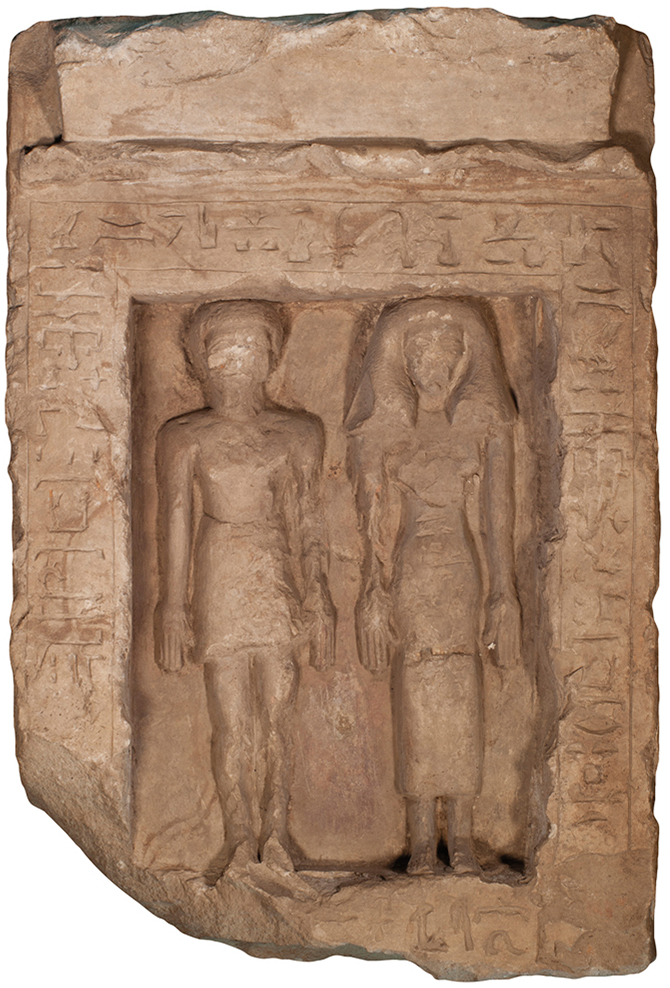 At Tell Edfu in southern Egypt, in a large villa dating to the beginning of the 18th Dynasty (ca. 1500–1450 B.C.), archaeologists have found evidence of the rise and fall of an elite couple. Near a small fireplace and offering table, they discovered objects including a carved limestone stela of a man and woman standing together. On the stela’s frame, hieroglyphic text identifies the man with the titles mayor and overseer of priests, the most important positions in the administration of Tell Edfu and its temple. This couple and their descendants, all of whom inhabited the villa, were members of an important family at a time when the rulers in the capital city of Thebes sought to consolidate their power by forging alliances with nobles in the south. At some point, the couple’s faces and names were hacked away for unknown reasons. “Somehow these family members had fallen out of favor, and their names were removed from the collective memory,” says Egyptologist Nadine Moeller, director of the University of Chicago’s Tell Edfu Project.
At Tell Edfu in southern Egypt, in a large villa dating to the beginning of the 18th Dynasty (ca. 1500–1450 B.C.), archaeologists have found evidence of the rise and fall of an elite couple. Near a small fireplace and offering table, they discovered objects including a carved limestone stela of a man and woman standing together. On the stela’s frame, hieroglyphic text identifies the man with the titles mayor and overseer of priests, the most important positions in the administration of Tell Edfu and its temple. This couple and their descendants, all of whom inhabited the villa, were members of an important family at a time when the rulers in the capital city of Thebes sought to consolidate their power by forging alliances with nobles in the south. At some point, the couple’s faces and names were hacked away for unknown reasons. “Somehow these family members had fallen out of favor, and their names were removed from the collective memory,” says Egyptologist Nadine Moeller, director of the University of Chicago’s Tell Edfu Project.
Tigress by the Tail
By HYUNG-EUN KIM
Thursday, April 11, 2019
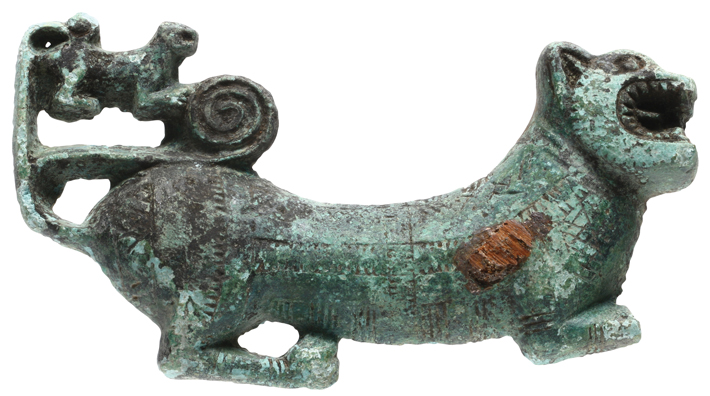 A belt buckle featuring a whimsical depiction of a tiger and its cub has been unearthed in the city of Cheongju in South Korea. The third-century A.D. bronze artifact depicts a crouching tigress with her mouth wide open, as if roaring, and a tiny cub in the same pose seated on her tail. Although tiger-shaped belt buckles have been found in the past, this is the first excavated example of a mother and baby tiger. It is also the first tiger-shaped buckle to have been discovered at Cheongju, a site belonging to the Mahan Confederacy, which existed between the first century B.C. and third century A.D. on the southern Korean peninsula, and about which little is known.
A belt buckle featuring a whimsical depiction of a tiger and its cub has been unearthed in the city of Cheongju in South Korea. The third-century A.D. bronze artifact depicts a crouching tigress with her mouth wide open, as if roaring, and a tiny cub in the same pose seated on her tail. Although tiger-shaped belt buckles have been found in the past, this is the first excavated example of a mother and baby tiger. It is also the first tiger-shaped buckle to have been discovered at Cheongju, a site belonging to the Mahan Confederacy, which existed between the first century B.C. and third century A.D. on the southern Korean peninsula, and about which little is known.
Stabbed in the Back
By DANIEL WEISS
Thursday, April 11, 2019
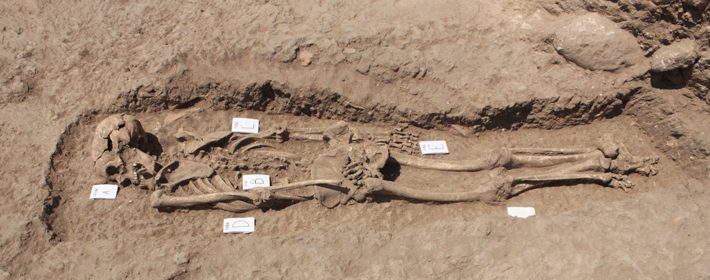 The skeleton of an eleventh-century man who appears to have been executed has been unearthed in central Sicily. When archaeologists led by Roberto Miccichè of the University of Palermo found the remains in a shallow grave, they immediately realized they had an unusual case on their hands. The man had been buried facedown, in a manner that did not follow any of the religious practices common in Sicily at the time. This suggests that he was an outlaw.
The skeleton of an eleventh-century man who appears to have been executed has been unearthed in central Sicily. When archaeologists led by Roberto Miccichè of the University of Palermo found the remains in a shallow grave, they immediately realized they had an unusual case on their hands. The man had been buried facedown, in a manner that did not follow any of the religious practices common in Sicily at the time. This suggests that he was an outlaw.
As Miccichè studied the bones using CT scans and a 3-D reconstruction, he recognized that the victim had been stabbed in the back at least six times, most likely while kneeling with his feet bound together. This is evidence of “someone very familiar with human anatomy carrying out a kind of ‘surgical operation’ intended to kill a person in a very effective and rapid way,” says Miccichè. He points out that the execution likely took place just after the Norman conquest of Sicily in 1061, a time of social upheaval when violence on the island was common.
A Fox in the House
By MARLEY BROWN
Thursday, April 11, 2019
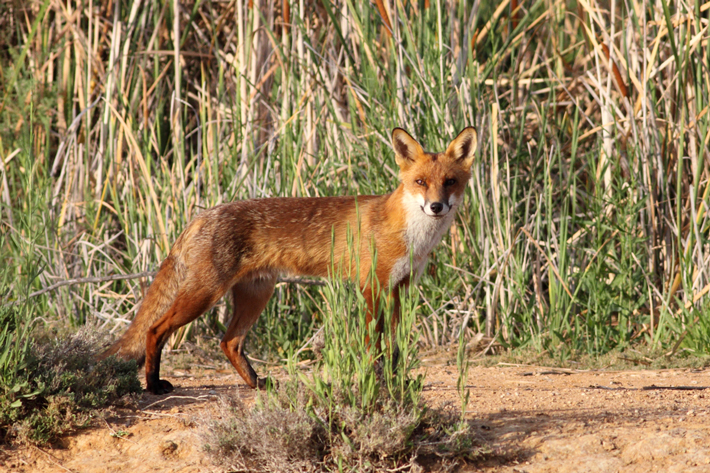 Four foxes buried alongside women at prehistoric sites in northeastern Spain offer insight into the value Bronze Age Iberians placed on their animal companions. The animals were unearthed in three graves dating to the end of the third to the beginning of the second millennium B.C. at the Catalan sites of Can Roqueta and Minferri. More than 30 dogs were also found. Isotope analysis of the foxes’ bone collagen suggests that they were regularly fed by villagers, most likely women, whose diet sometimes differed from that of men. For example, at Can Roqueta, men ate more meat than women. “Foxes are associated with women, not only in the grave but also in what they ate,” says Aurora Grandal-d’Anglade of the University of A Coruña. “The foxes show isotopic signatures consistent with a diet similar to those of women and children.” While dogs at both sites appear to have been bred for daily tasks such as bearing loads, the foxes were likely free to wander. “I think the foxes were probably friendly animals used to humans,” Grandal-d’Anglade says. “It’s possible that women and children found it entertaining to attract and feed them.”
Four foxes buried alongside women at prehistoric sites in northeastern Spain offer insight into the value Bronze Age Iberians placed on their animal companions. The animals were unearthed in three graves dating to the end of the third to the beginning of the second millennium B.C. at the Catalan sites of Can Roqueta and Minferri. More than 30 dogs were also found. Isotope analysis of the foxes’ bone collagen suggests that they were regularly fed by villagers, most likely women, whose diet sometimes differed from that of men. For example, at Can Roqueta, men ate more meat than women. “Foxes are associated with women, not only in the grave but also in what they ate,” says Aurora Grandal-d’Anglade of the University of A Coruña. “The foxes show isotopic signatures consistent with a diet similar to those of women and children.” While dogs at both sites appear to have been bred for daily tasks such as bearing loads, the foxes were likely free to wander. “I think the foxes were probably friendly animals used to humans,” Grandal-d’Anglade says. “It’s possible that women and children found it entertaining to attract and feed them.”
Off the Grid
By MARLEY BROWN
Thursday, April 11, 2019
 Kakadu National Park in Australia’s Northern Territory, a roughly three-hour drive southeast from the territory’s capital, Darwin, is one of the greatest rock-art landscapes in the world. Recent archaeological excavations have pushed back the earliest dates of human presence in the region to around 65,000 years ago. More than 5,000 sites with petroglyphs have been recorded within the park’s 8,000 square miles. Pinning down the precise date of some of Kakadu’s rock art is challenging, as many of the mineral pigments used in the area are not datable using radiocarbon methods. Therefore, says Samantha McLean of Kakadu’s research and permits office, archaeologists and art historians have constructed timelines for the art using a combination of thermoluminescence dating, which can determine when mineral elements of paint or ceramics were first heated or fired, and representations of flora and fauna, which have changed over time along with the climate. Some of the most stunning images in Kakadu are found on or near Nourlangie Rock, a massive sandstone formation about a half-hour drive south from Jabiru, the park’s largest hub, which has facilities such as hotels and welcome centers. Another of the rock art sites, called Nanguluwur, was used as a campsite by ancestors of the Bininj/Mungguy people for millennia, and features an array of paintings and hand stencils ranging from several thousand to fewer than 100 years old. “Here you can see powerful depictions of ancestral spirits, animals, as well as fascinating early illustrations of contact between Aboriginal people and Europeans,” says McLean.
Kakadu National Park in Australia’s Northern Territory, a roughly three-hour drive southeast from the territory’s capital, Darwin, is one of the greatest rock-art landscapes in the world. Recent archaeological excavations have pushed back the earliest dates of human presence in the region to around 65,000 years ago. More than 5,000 sites with petroglyphs have been recorded within the park’s 8,000 square miles. Pinning down the precise date of some of Kakadu’s rock art is challenging, as many of the mineral pigments used in the area are not datable using radiocarbon methods. Therefore, says Samantha McLean of Kakadu’s research and permits office, archaeologists and art historians have constructed timelines for the art using a combination of thermoluminescence dating, which can determine when mineral elements of paint or ceramics were first heated or fired, and representations of flora and fauna, which have changed over time along with the climate. Some of the most stunning images in Kakadu are found on or near Nourlangie Rock, a massive sandstone formation about a half-hour drive south from Jabiru, the park’s largest hub, which has facilities such as hotels and welcome centers. Another of the rock art sites, called Nanguluwur, was used as a campsite by ancestors of the Bininj/Mungguy people for millennia, and features an array of paintings and hand stencils ranging from several thousand to fewer than 100 years old. “Here you can see powerful depictions of ancestral spirits, animals, as well as fascinating early illustrations of contact between Aboriginal people and Europeans,” says McLean.
THE SITE
To experience the park fully can take several days. Visitors should begin their journey at the Warradjan Aboriginal Cultural Centre, where interpretive displays and presentations share the culture of Kakadu’s people. From there, it’s about a 45-minute drive east along the Kakadu Highway following signs for Nourlangie Rock, which is also known as Burrunggui. There are no shuttles around the park, so visitors are encouraged to sign up with one of the many commercial tour operators or to explore in their own vehicles. From May to November, the park offers guided tours, talks, and activities, which are included in the entrance fee. A range of hotels, cabins, and campsites can be found near the park’s four main hubs. Once you reach Nanguluwur, the site and the nearby Anbangbang rock shelter have well-marked walking tracks and are protected by guardrails.
WHILE YOU’RE THERE 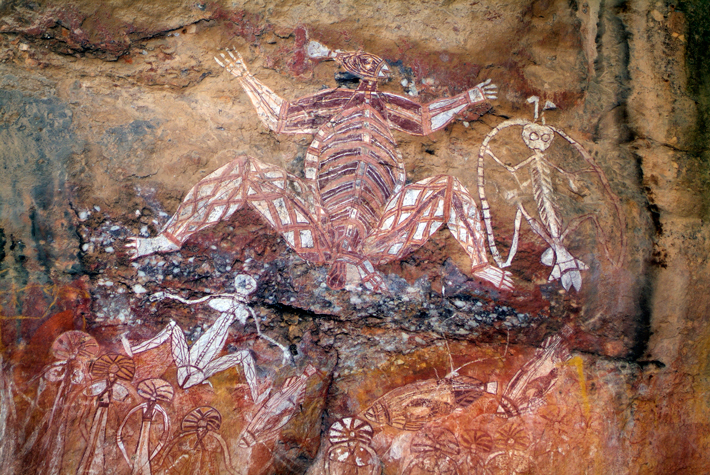
Nanguluwur is a short walk to the entrance to the Anbangbang billabong, the wetlands habitat of an impressive array of birdlife. Spread out your lunch on one of many picnic tables and raise your binoculars to catch sight of magpie geese, combcrested jacanas, cormorants, and redtailed black cockatoos, to name only a few of the avian species you might see.
Advertisement
Advertisement
IN THIS ISSUE
Features
Mapping the Past
Bringing Back Moche Badminton
Inside King Tut’s Tomb
Letter from the Dead Sea
From the Trenches
Epic Proportions
Off the Grid
Stabbed in the Back
A Fox in the House
Tigress by the Tail
Family Secrets
Cold War Storage
Marrow of Humanity
Maya Beekeepers
Roman Soldier Scribbles
Understanding Hornet's Fate
Viking Warrioress
Colonial Cooling
Temple of the Flayed Lord
Celtic Curiosity
Submerged Scottish Forest
World Roundup
American whaler petroglyphs, Chinese “elixir of immortality,” Neanderthal footprints, and Ice Age rabbit hunting
Artifact
At some point in the past
Advertisement

Recent Issues
-
 May/June 2024
May/June 2024
-
 March/April 2024
March/April 2024
-
 January/February 2024
January/February 2024
-
 November/December 2023
November/December 2023
-
 September/October 2023
September/October 2023
-
 July/August 2023
July/August 2023
-
 May/June 2023
May/June 2023
-
 March/April 2023
March/April 2023
-
 January/February 2023
January/February 2023
-
 November/December 2022
November/December 2022
-
 September/October 2022
September/October 2022
-
 July/August 2022
July/August 2022
-
 May/June 2022
May/June 2022
-
 March/April 2022
March/April 2022
-
 January/February 2022
January/February 2022
-
 November/December 2021
November/December 2021
-
 September/October 2021
September/October 2021
-
 July/August 2021
July/August 2021
-
 May/June 2021
May/June 2021
-
 March/April 2021
March/April 2021
-
 January/February 2021
January/February 2021
-
 November/December 2020
November/December 2020
-
 September/October 2020
September/October 2020
-
 July/August 2020
July/August 2020
-
 May/June 2020
May/June 2020
-
 March/April 2020
March/April 2020
-
 January/February 2020
January/February 2020
-
 November/December 2019
November/December 2019
-
 September/October 2019
September/October 2019
-
 July/August 2019
July/August 2019
-
 May/June 2019
May/June 2019
-
 March/April 2019
March/April 2019
-
 January/February 2019
January/February 2019
-
 November/December 2018
November/December 2018
-
 September/October 2018
September/October 2018
-
 July/August 2018
July/August 2018
-
 May/June 2018
May/June 2018
-
 March/April 2018
March/April 2018
-
 January/February 2018
January/February 2018
-
 November/December 2017
November/December 2017
-
 September/October 2017
September/October 2017
-
 July/August 2017
July/August 2017
-
 May/June 2017
May/June 2017
-
 March/April 2017
March/April 2017
-
 January/February 2017
January/February 2017
-
 November/December 2016
November/December 2016
-
 September/October 2016
September/October 2016
-
 July/August 2016
July/August 2016
-
 May/June 2016
May/June 2016
-
 March/April 2016
March/April 2016
-
 January/February 2016
January/February 2016
-
 November/December 2015
November/December 2015
-
 September/October 2015
September/October 2015
-
 July/August 2015
July/August 2015
-
 May/June 2015
May/June 2015
-
 March/April 2015
March/April 2015
-
 January/February 2015
January/February 2015
-
 November/December 2014
November/December 2014
-
 September/October 2014
September/October 2014
-
 July/August 2014
July/August 2014
-
 May/June 2014
May/June 2014
-
 March/April 2014
March/April 2014
-
 January/February 2014
January/February 2014
-
 November/December 2013
November/December 2013
-
 September/October 2013
September/October 2013
-
 July/August 2013
July/August 2013
-
 May/June 2013
May/June 2013
-
 March/April 2013
March/April 2013
-
 January/February 2013
January/February 2013
-
 November/December 2012
November/December 2012
-
 September/October 2012
September/October 2012
-
 July/August 2012
July/August 2012
-
 May/June 2012
May/June 2012
-
 March/April 2012
March/April 2012
-
 January/February 2012
January/February 2012
-
 November/December 2011
November/December 2011
-
 September/October 2011
September/October 2011
-
 July/August 2011
July/August 2011
-
 May/June 2011
May/June 2011
-
 March/April 2011
March/April 2011
-
 January/February 2011
January/February 2011
Advertisement






